
A partial lunar eclipse occurred at the Moon’s ascending node of orbit on Wednesday, May 25, 1994, with an umbral magnitude of 0.2432. A lunar eclipse occurs when the Moon moves into the Earth's shadow, causing the Moon to be darkened. A partial lunar eclipse occurs when one part of the Moon is in the Earth's umbra, while the other part is in the Earth's penumbra. Unlike a solar eclipse, which can only be viewed from a relatively small area of the world, a lunar eclipse may be viewed from anywhere on the night side of Earth. Occurring only about 23.5 hours after perigee, the Moon's apparent diameter was larger.

A partial lunar eclipse occurred at the Moon’s descending node of orbit on Saturday, December 21, 1991, with an umbral magnitude of 0.0876. A lunar eclipse occurs when the Moon moves into the Earth's shadow, causing the Moon to be darkened. A partial lunar eclipse occurs when one part of the Moon is in the Earth's umbra, while the other part is in the Earth's penumbra. Unlike a solar eclipse, which can only be viewed from a relatively small area of the world, a lunar eclipse may be viewed from anywhere on the night side of Earth. Occurring only about 23 hours before perigee, the Moon's apparent diameter was larger.

A penumbral lunar eclipse occurred at the Moon’s descending node of orbit on Thursday, March 3, 1988, with an umbral magnitude of −0.0016. It was a relatively rare total penumbral lunar eclipse, with the Moon passing entirely within the penumbral shadow without entering the darker umbral shadow. A lunar eclipse occurs when the Moon moves into the Earth's shadow, causing the Moon to be darkened. A penumbral lunar eclipse occurs when part or all of the Moon's near side passes into the Earth's penumbra. Unlike a solar eclipse, which can only be viewed from a relatively small area of the world, a lunar eclipse may be viewed from anywhere on the night side of Earth. Occurring about 2.2 days after apogee, the Moon's apparent diameter was smaller.
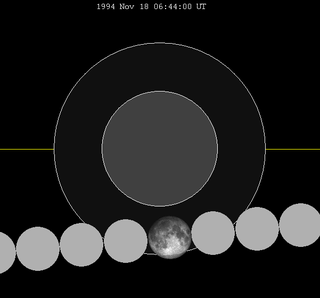
A penumbral lunar eclipse occurred at the Moon’s descending node of orbit on Friday, November 18, 1994, with an umbral magnitude of −0.2189. A lunar eclipse occurs when the Moon moves into the Earth's shadow, causing the Moon to be darkened. A penumbral lunar eclipse occurs when part or all of the Moon's near side passes into the Earth's penumbra. Unlike a solar eclipse, which can only be viewed from a relatively small area of the world, a lunar eclipse may be viewed from anywhere on the night side of Earth. Occurring only about 1.5 hours after apogee, the Moon's apparent diameter was smaller.

A penumbral lunar eclipse occurred at the Moon’s descending node of orbit on Tuesday, May 15, 1984, with an umbral magnitude of −0.1759. A lunar eclipse occurs when the Moon moves into the Earth's shadow, causing the Moon to be darkened. A penumbral lunar eclipse occurs when part or all of the Moon's near side passes into the Earth's penumbra. Unlike a solar eclipse, which can only be viewed from a relatively small area of the world, a lunar eclipse may be viewed from anywhere on the night side of Earth. Occurring about 3 days after perigee, the Moon's apparent diameter was larger.

A penumbral lunar eclipse occurred at the Moon’s descending node of orbit on Monday, March 25, 2024, with an umbral magnitude of −0.1304. A lunar eclipse occurs when the Moon moves into the Earth's shadow, causing the Moon to be darkened. A penumbral lunar eclipse occurs when part or all of the Moon's near side passes into the Earth's penumbra. Unlike a solar eclipse, which can only be viewed from a relatively small area of the world, a lunar eclipse may be viewed from anywhere on the night side of Earth. Occurring about 2.2 days after apogee, the Moon's apparent diameter was smaller.

A partial lunar eclipse will occur at the Moon’s ascending node of orbit on Friday, August 28, 2026, with an umbral magnitude of 0.9319. A lunar eclipse occurs when the Moon moves into the Earth's shadow, causing the Moon to be darkened. A partial lunar eclipse occurs when one part of the Moon is in the Earth's umbra, while the other part is in the Earth's penumbra. Unlike a solar eclipse, which can only be viewed from a relatively small area of the world, a lunar eclipse may be viewed from anywhere on the night side of Earth. Occurring about 6 days after perigee, the Moon's apparent diameter will be larger.

A penumbral lunar eclipse will occur at the Moon’s descending node of orbit on Saturday, February 20, 2027, with an umbral magnitude of −0.0549. A lunar eclipse occurs when the Moon moves into the Earth's shadow, causing the Moon to be darkened. A penumbral lunar eclipse occurs when part or all of the Moon's near side passes into the Earth's penumbra. Unlike a solar eclipse, which can only be viewed from a relatively small area of the world, a lunar eclipse may be viewed from anywhere on the night side of Earth. Occurring about 1.5 days after perigee, the Moon's apparent diameter will be larger.

A penumbral lunar eclipse will occur at the Moon’s descending node of orbit on Monday, December 9, 2030, with an umbral magnitude of −0.1613. A lunar eclipse occurs when the Moon moves into the Earth's shadow, causing the Moon to be darkened. A penumbral lunar eclipse occurs when part or all of the Moon's near side passes into the Earth's penumbra. Unlike a solar eclipse, which can only be viewed from a relatively small area of the world, a lunar eclipse may be viewed from anywhere on the night side of Earth. Occurring only about 7.5 hours before apogee, the Moon's apparent diameter will be smaller.

A penumbral lunar eclipse occurred at the Moon’s descending node of orbit on Saturday, November 6, 1976, with an umbral magnitude of −0.2593. A lunar eclipse occurs when the Moon moves into the Earth's shadow, causing the Moon to be darkened. A penumbral lunar eclipse occurs when part or all of the Moon's near side passes into the Earth's penumbra. Unlike a solar eclipse, which can only be viewed from a relatively small area of the world, a lunar eclipse may be viewed from anywhere on the night side of Earth. Occurring only about 8 hours after apogee, the Moon's apparent diameter was smaller.
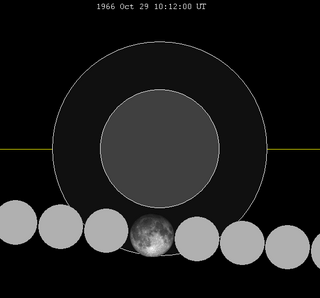
A penumbral lunar eclipse occurred at the Moon’s ascending node of orbit on Saturday, October 29, 1966, with an umbral magnitude of −0.1249. A lunar eclipse occurs when the Moon moves into the Earth's shadow, causing the Moon to be darkened. A penumbral lunar eclipse occurs when part or all of the Moon's near side passes into the Earth's penumbra. Unlike a solar eclipse, which can only be viewed from a relatively small area of the world, a lunar eclipse may be viewed from anywhere on the night side of Earth. Occurring about 4 days after apogee, the Moon's apparent diameter was smaller.

A penumbral lunar eclipse occurred at the Moon’s ascending node of orbit on Wednesday, December 8, 1965, with an umbral magnitude of −0.1200. A lunar eclipse occurs when the Moon moves into the Earth's shadow, causing the Moon to be darkened. A penumbral lunar eclipse occurs when part or all of the Moon's near side passes into the Earth's penumbra. Unlike a solar eclipse, which can only be viewed from a relatively small area of the world, a lunar eclipse may be viewed from anywhere on the night side of Earth. Occurring about 2.5 days before perigee, the Moon's apparent diameter was larger.
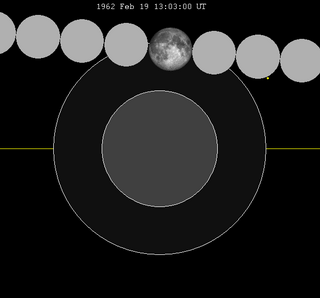
A penumbral lunar eclipse occurred at the Moon’s ascending node of orbit on Monday, February 19, 1962, with an umbral magnitude of −0.4865. A lunar eclipse occurs when the Moon moves into the Earth's shadow, causing the Moon to be darkened. A penumbral lunar eclipse occurs when part or all of the Moon's near side passes into the Earth's penumbra. Unlike a solar eclipse, which can only be viewed from a relatively small area of the world, a lunar eclipse may be viewed from anywhere on the night side of Earth. Occurring about 1.3 days before apogee, the Moon's apparent diameter was smaller.

A partial lunar eclipse occurred at the Moon’s ascending node of orbit on Tuesday, March 24, 1959, with an umbral magnitude of 0.2643. A lunar eclipse occurs when the Moon moves into the Earth's shadow, causing the Moon to be darkened. A partial lunar eclipse occurs when one part of the Moon is in the Earth's umbra, while the other part is in the Earth's penumbra. Unlike a solar eclipse, which can only be viewed from a relatively small area of the world, a lunar eclipse may be viewed from anywhere on the night side of Earth. Occurring about 1.5 days before perigee, the Moon's apparent diameter was larger.

A partial lunar eclipse occurred at the Moon’s ascending node of orbit on Thursday, May 24, 1956, with an umbral magnitude of 0.9647. A lunar eclipse occurs when the Moon moves into the Earth's shadow, causing the Moon to be darkened. A partial lunar eclipse occurs when one part of the Moon is in the Earth's umbra, while the other part is in the Earth's penumbra. Unlike a solar eclipse, which can only be viewed from a relatively small area of the world, a lunar eclipse may be viewed from anywhere on the night side of Earth. Occurring about 4.3 days before apogee, the Moon's apparent diameter was smaller.

A total lunar eclipse occurred at the Moon’s descending node of orbit on Thursday, January 29, 1953, with an umbral magnitude of 1.3314. It was a central lunar eclipse, in which part of the Moon passed through the center of the Earth's shadow. A lunar eclipse occurs when the Moon moves into the Earth's shadow, causing the Moon to be darkened. A total lunar eclipse occurs when the Moon's near side entirely passes into the Earth's umbral shadow. Unlike a solar eclipse, which can only be viewed from a relatively small area of the world, a lunar eclipse may be viewed from anywhere on the night side of Earth. A total lunar eclipse can last up to nearly two hours, while a total solar eclipse lasts only a few minutes at any given place, because the Moon's shadow is smaller. Occurring about 2.5 days before apogee, the Moon's apparent diameter was smaller.
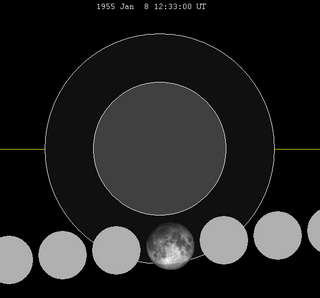
A penumbral lunar eclipse occurred at the Moon’s descending node of orbit on Saturday, January 8, 1955, with an umbral magnitude of −0.1421. A lunar eclipse occurs when the Moon moves into the Earth's shadow, causing the Moon to be darkened. A penumbral lunar eclipse occurs when part or all of the Moon's near side passes into the Earth's penumbra. Unlike a solar eclipse, which can only be viewed from a relatively small area of the world, a lunar eclipse may be viewed from anywhere on the night side of Earth. Occurring about 2.2 days after perigee, the Moon's apparent diameter was larger.

A penumbral lunar eclipse will occur at the Moon’s descending node of orbit on Friday, March 3, 2045, with an umbral magnitude of −0.0148. A lunar eclipse occurs when the Moon moves into the Earth's shadow, causing the Moon to be darkened. A penumbral lunar eclipse occurs when part or all of the Moon's near side passes into the Earth's penumbra. Unlike a solar eclipse, which can only be viewed from a relatively small area of the world, a lunar eclipse may be viewed from anywhere on the night side of Earth. Occurring about 1.8 days after perigee, the Moon's apparent diameter will be larger.
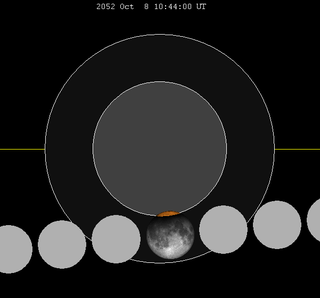
A partial lunar eclipse will occur at the Moon’s descending node of orbit on Tuesday, October 8, 2052, with an umbral magnitude of 0.0821. A lunar eclipse occurs when the Moon moves into the Earth's shadow, causing the Moon to be darkened. A partial lunar eclipse occurs when one part of the Moon is in the Earth's umbra, while the other part is in the Earth's penumbra. Unlike a solar eclipse, which can only be viewed from a relatively small area of the world, a lunar eclipse may be viewed from anywhere on the night side of Earth. Occurring about 2.1 days before perigee, the Moon's apparent diameter will be larger.

A penumbral lunar eclipse will occur at the Moon’s ascending node of orbit on Tuesday, March 4, 2053, with an umbral magnitude of −0.0796. A lunar eclipse occurs when the Moon moves into the Earth's shadow, causing the Moon to be darkened. A penumbral lunar eclipse occurs when part or all of the Moon's near side passes into the Earth's penumbra. Unlike a solar eclipse, which can only be viewed from a relatively small area of the world, a lunar eclipse may be viewed from anywhere on the night side of Earth. Occurring about 4.1 days after perigee, the Moon's apparent diameter will be larger.
















































































